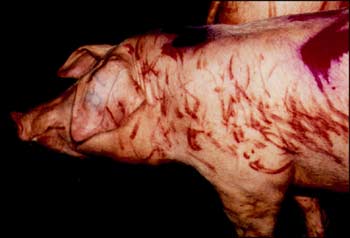Reduce aggression
Castration has been practised for easier control of the behaviour of pigs, because the sex hormones produced in entire male pigs have a number of behavioural effects (Signoret, 1976).
Entire male pigs are more aggressive than gilts and the more docile castrated pigs (Lundström et al., 1987; Cronin et al., 2003; Rydhmer et al., 2006). Fighting, for example associated with the mixing of unfamiliar pigs can lead to skin lesions and can result in reduced growth rate in conventional indoor systems.
Fighting and exhaustion can also lead to a deterioration of meat quality measured by higher frequency of dark, firm and dry (DFD) meat (Walker, 1978; Warriss, 2000).

Pig with skin damage after fight in Danish slaughter plant. Source: Laurits Lydehöj Hansen.
It is likely that aggression will lead not only to poor welfare, but also to increased androstenone levels (Claus et al., 1994; EFSA, 2004). Enriched environments with more space and deep litter give pigs increased opportunities to express their natural behaviour and reduce aggressive behaviour (EFSA, 2004).
Definition: Natural behaviour
Natural behaviour is a behaviour that an animal is strongly motivated to perform and when performed gives the animal a functional feed-back (Algers, 1992; Algers, 2008).
It is also likely that restrictive factors in the rearing environment, creating competitive conditions are more critical in the production of entire male pigs (EFSA, 2004).
The increased aggressive and sexual behaviour of entire males may therefore require improved standards for floor space, floor quality, feeder space, substrate/bedding and pen lay-out. Inadequacies in these factors may result in increased skin and leg injuries and higher general stress levels if pigs cannot escape or avoid harassment by particularly active males. The effects of these factors on levels of boar taint are not documented, and will also depend on slaughter weight.
Directive 91/630/EEC stipulates that pigs should be kept in intact groups with as little mixing as possible. If pigs that are unfamiliar with one another have to be mixed, this should be done at as young an age as possible, preferably before weaning or up to one week after weaning. When pigs are mixed they must be provided with adequate opportunities to escape and hide from other pigs.